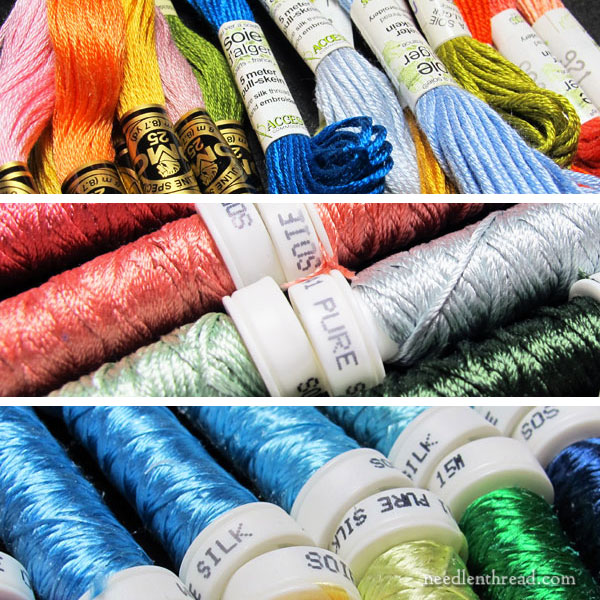Good morning, and Happy Monday!
When we started warming up for the Autumn Fire stitch-along (which launched last week with the design and which we start stitching on Wednesday), many questions about silk embroidery threads started rolling in. In most cases, these questions are from our fellow stitchers out there who haven’t had the opportunity to work with silk threads and who feel a little intimidated by the idea.
That’s why today, I want to offer you – especially if you’re new to Needle ‘n Thread – some previous articles on silk threads. If you’ve not embroidered with silk before and it seems like a mysterious and inaccessible thread to you, hopefully this will put your mind at ease and perhaps it may even open up a whole new world of fiber for you!

When it comes to silk thread, I always suggest that beginners to silk start with the most familiar silk. By most familiar, I mean the silk that behaves in a fashion that you’re already familiar with, if you normally use stranded cotton for needlework.
The silk that easily equates with stranded cotton in behavior and use is spun silk that’s stranded like cotton. It comes off the skein in a “rope” that’s made up of a number of strands of silk thread. You separate individual strands into the number you want to use, just like when you “strip” stranded cotton threads into the number of strands you want to use before stitching with it. The number of strands you use will determine the weight (or “thickness”) of your embroidered line.
Stranded spun silk is the easiest silk thread to stitch with, which is one of the reasons why I used it on Autumn Fire. It makes a great introduction to silk thread.
But this isn’t to say it’s some kind of “inferior” or “beginner” silk thread that’s at the bottom of some kind of Scale of Silk Threads. It’s just that its make-up is familiar to anyone who has used stranded cotton.
Soie d’Alger – the stranded spun silk from Au Ver a Soie, a well-known and highly respected French company that’s been producing silk threads for centuries – is a luxurious, lovely silk thread. It’s perfect for all kinds of embroidery, from line stitching to needle painting or silk shading. It blends together so smoothly and lustrously for silk shading, that it’s hard to go back to cotton after you’ve used it for this technique! You can see a beautiful example of silk shading using Soie d’Alger here.
But Soie d’Alger (which is the thread I use in the Autumn Fire kit) is not the only stranded spun silk on the market. There are many other brands out there. I usually use Soie d’Alger because it is consistent, high quality silk thread.
Introductory Articles for Silk Embroidery Threads
The following three articles on silk threads will familiarize you a little more with silk:
Silk Hand Embroidery Thread 101: Getting Started with Silk – an introduction and exploration of spun silk
Silk Hand Embroidery Thread 101: Twisted Filament Silk
Silk Hand Embroidery Thread 101: Flat Silk
There are many, many more articles on Needle ‘n Thread about silk embroidery threads or embroidery projects involving silk threads, and you can find them all listed here, under the topic tag “silk.”
I’m working up a little sample to illustrate an upcoming article on silk thread, so keep an eye out for that if you’re keen to know a little more about silk hand embroidery threads!
We’ll catch up next on Wednesday, when we will move forward with Autumn Fire. See you then!







You’ve inspired me to finally buy a good layering tool, Mary.
It’s been a long time coming.
14 years ago, when I retired, I decided my first embroidery project would be decorating a quilt (made with fabric I bought in France a long time ago) with leaves made of flat silk I bought from the Japanese Embroidery Center. Alas- for the leaf-strewn quilt, I spent all my time rolling the flat silk into stranded threads (it was a blast!) and never learned how to lay down flat silk.
I can’t wait to try the layering tool.
So, it’s down another rabbit hole for me.
And thanks for the prod!
Christine